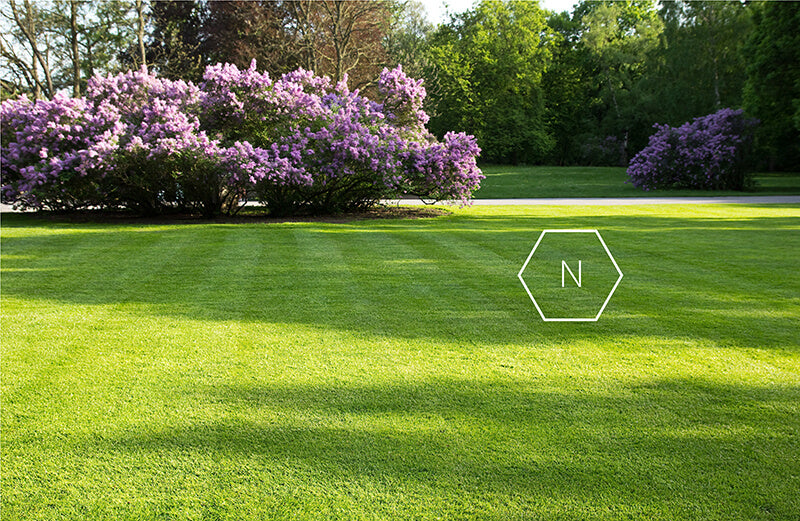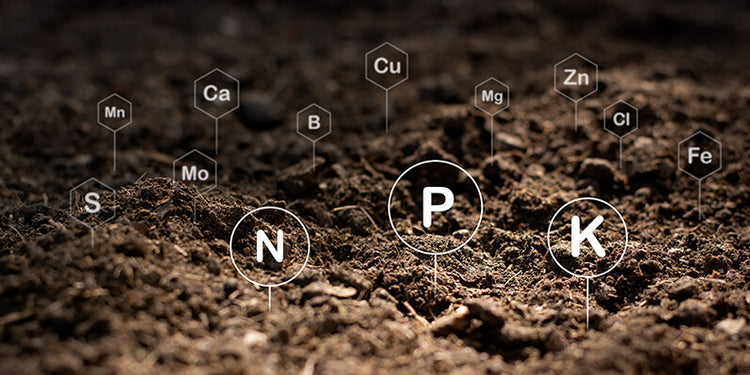While all nutrients are essential for plant life, Nitrogen(N) is the element that is required in the greatest amounts to maintain healthy and vigorous plant growth. It is also not very understood. As you will see, using organic sources for your plant nutrients is a lot different than just buying a bag of fertilizer. Let's dive in to better understand how it works and the effects of organic nitrogen in the soil.
The interesting thing about nitrogen (in its natural form) is that it’s not derived from the soil like other nutrients, but comes from organic matter. Nitrogen released by soil microbes enters the soil as ammonia. Nitrifying bacteria convert ammonia to different forms, including nitrates, the form of nitrogen plants most readily use. If your soil is low in microbes, you will lose much of this ammonia to the air, lowering soil nitrogen levels. Therefore, it is essential to maintain your soil correctly. To help in this, Turf Formula is time tested and increases microbial levels and activity tremendously, which is vital to plant and microbial health. It helps deliver nitrogen and other nutrients faster and more efficiently for plants to use.
Consider how meadows, forests, and rangelands thrive yet do not receive supplemental nitrogen. They are dependent on a constant supply of organic matter to meet their nitrogen needs. In order for lawns and fields to maintain organic nitrogen in soils, organic matter comes from biodegradable materials such as grass clippings, shed roots, fallen leaves, decomposing twigs and branches, dead insect bodies, earthworm, insect, rodent and animal feces, and the like. Leaving grass clippings on the lawn can return 1 - 2 lbs of nitrogen per 1000 sqft each year back to the soil.
Fertilizer bags always include three large numbers on the bag that represent Nitrogen, Phosphorus, and Potassium, in that order. It may have 0 for any of those nutrients if the bag contains none, but companies list them. Most of the fertilization programs professionally developed for turf are based on the amount of N needed on the grass for that time of year. It is equally important for organic lawn care. In turf science, it is said that a person skilled in Nitrogen management separates the true professionals from the average fertilizer user. Professionals are required to know this.
Another interesting fact that runs contrary to popular belief is plants do not know or care where the nitrogen comes from. Whether through the breakdown of organic matter or by synthetic fertilizers, grass only knows it is nitrogen and will use it just the same.
The Important Role of Soil Microorganisms to Grass Plant Health
While the grass doesn't care about the nitrogen source, what about the soil? While it is true that some forms of nitrogen, such as ammonium, can harm some soil bacteria, it is only for a short time. As explained by the Texas A&M Agricultural Science Dept., soil bacteria immune to ammonium break it down into a plant-available nutrient. Then the harmed bacteria begin to recover rapidly. If the bacteria didn't recover, the world would be in severe danger since 80% of the world's ammonium is used as fertilizer.
To give you an example of how nature works, consider oil spills. Millions of spilled oil gallons can cause severe damage to birds, fish, microbes, and plant life. It upsets the whole balance of nature. Man tries his best to clean it up, but much of it is impossible to reach.
This is where microbes come in. What is harmful to one microbe is like Swiss Chocolate to another. Oil digesting microbes can quickly breakdown the oil, and as that happens, the original microbes that were damaged by the oil soon return. This is what happened in the Gulf of Mexico during the BP spill. Within a relatively short time, the oil that pushed deep into the marsh was gone, and life sprang back. Life at the beach - crabbing, shrimping, and fishing - are now back to normal.
If you have an organic lawn care service or strive to use organics as much as possible, maintaining your soil microbes is of supreme importance. There is nothing quite like Turf Formula® for home and sports turf, or FoliarBlend® for fields related to the most active and numerous microbial activity. University studies have shown Turf Formula® increases your natural microbial activity by up to 5000% in as little 72 hours. Soil microbes break down soil elements into nutrients plants can actually use, and it does it much faster. These microbes provide enzymes, amino acids, and other essential elements plants need for root development and overall plant health (read more on Sports Field Maintenance).
Role of Nitrogen Inside the Plant

Magnesium is found inside the grass plant at the Chlorophyll molecule center, but three Nitrogen ions surround magnesium. Chlorophyll gives plants their green color and uses large amounts of nitrogen. Nitrogen is also found in amino acids, proteins, enzymes, nucleic acids, and more. It is an essential element for grass blade development, root and runner growth, photosynthesis, and other plant functions. Therefore, healthy grass is dependent on the correct amount of nitrogen availability.
As already stated, soil microorganisms break down the organic matter and release back into the soil many different nutrients. The microorganism's activity is related to temperature, with the greatest activity in the high heat of summer and winter being the slowest. As long as soil moisture is adequate, summer marks the fastest organic matter conversion back into nutrients.
To further challenge things, nitrogen is unstable in soil. This is the primary reason soil tests often do not record Nitrogen levels, because it is so unstable, and levels quickly change. Suppose you are using organic forms of nitrogen. In that case, you need to keep a supply of organic material available to plants, especially from the start of the growing season, through the summer months and fall when microbes are at their highest activity levels. Organic matter can take many forms. Organic fertilizers, such as Milorganite, composted poultry litter, have all been used successfully. The latter generally have higher nitrogen levels than other manures at about 4% N. There are also "bridge products" that combine urea and other forms of N with the organic matter for increased nitrogen levels.
Some companies make well-composted granulated manure fertilizers that are very safe. However, organic fertilizers cost more than non-organic. You can also use high-quality loamy topsoil or composts.
Driving these points home, if you are doing organics, especially if you have an organic business, do not rely on nature alone. Your business depends on it. Keep track of organic matter levels via a soil test and the application rate of organic material afterward. If your soil is low in organic material, you will have low organic nitrogen levels in soil, and your grass will not be as green. As a result, your grass will show signs of chlorosis. You may not have enough nutrients to maintain the dark green color needed for healthy plants, and you will need to make organic additions or add fertilizers.
Remember that chlorotic grass has lower disease resistance, lowered photosynthetic activity, and root development. It may go into dormancy to protect itself earlier when healthier grass would be green and thriving. You need to add Turf Formula to keep the microbial numbers high to convert soil elements and organic matter into nutrients.
If your soil is high in organic matter (6% organic matter is sufficient), then low maintenance turf can easily survive through the year. Places where clippings are left on the grass, such as home lawns, low traffic parks, cemeteries, amenity grasslands, etc., can often survive without nitrogen applications. Suppose your soil is lacking in organic matter. In that case, there may not be enough nitrogen to sustain healthy and vigorous plant life. You will need to add nitrogen in the form of fertilizers or add organic matter through top dressing with loamy topsoils or composts. Sports turf has higher standards, and nutrient levels will need to be closely monitored (check out the article on why Organic Matter Matters).
How Much Topsoil Should I Get

Another question to consider is, "how much topsoil will it take to cover my front yard with 1/2" deep of good loamy soil?"
If purchased in large volumes, it often will come in cubic yards. To get an idea of how much that is, first imagine a child's toy blocks. They often have letters on them, and you can stack them. Place nine blocks on the floor in a solid square three blocks wide and three blocks long. Then stack two more sets of blocks exactly like it one top of each other. Now you have 27 blocks in three rows of three on every side. If those blocks were one ft square (each block is 12" on each side), you would have 27 of them, which would equal a cubic yard. That is a lot of dirt.
Where to begin:
To answer how many cubic yards of topsoil you need, you will first need to know how many square feet is in your yard. So if your lawn is 50 ft X 25 ft, you have 1250 ft².
Since we are talking in fractions of 1/2", we first need to convert the fraction into feet to calculate the volume of material. Here's how we do that:
1/2 in depth = 1 ÷ 2 = .5 inches or half an inch **(if you needed 3/4" deep of topsoil the math would be 3 ÷ 4 = .75 inches**)
Now divide: .5 in ÷ 12 in/ft² = .041 ft²
Then to get the volume of material needed for 1/2" deep:
Front Yard Sqft = 1250 ft² X .041 ft² = 51.25³ (The 3 reprepresents "cubic feet")
You will need 51.25 cubic feet to topsoil to cover it 1/2" in-depth.
Now, if you will need to order it in cubic yards:
If one cubic yard = 27³ cubic feet, then how many cubic yards are 51.25³ cubic feet?
Divide: 51.25³ ÷ 27³ = 1.89 Cubic Yards. You will need just under two cubic yards. You can round it up to two if you like to make it easier for the guy loading it.
Conclusions:
You can apply Turf Formula®, or Turf Formula® mixed with SuperCal® Liquid Calcium, right over the top of the soil. In a test conducted by the University of Missouri where Turf Formula® and SuperCal® were applied, Brown Patch disease pathogens were reduced by 35% within 72 hours over the control. Many beneficial microbes feed on pathogenic microbes, and this action may be enough to keep most diseases from becoming problems (check out the study here and AgriGro’s prebiotic impact on soil diversity and richness).
The use of Turf Formula® has helped control Take-All Root Rot, Cedar Apple Rust, Pythium Blight, as well as other diseases. Cedar Apple Rust on apple trees was controlled entirely the year it was tested. The following year the Turf Formula® application was withheld to see what would happen, and the cedar-apple rust came back. Turf Formula® is not a fungicide, but by increasing beneficial microbes, many bacteria and protozoa have one primary function: to find and kill pathogenic microbes. Turf Formula® significantly increases fluid uptake, promotes significant root growth, and aids in more efficient photosynthesis.
AgriGro products have become a valuable, time-tested resource for organic and non-organic lawn care professionals, used on golf courses and lawns around the country and around the world. If you haven't tried it, now's the time.
Russ James
AgriGro Turf Specialist
Call Russ / Email Russ

Sources:
Lawn Care Academy Turf Specialist, Russ James
Fundamentals of TurfGrass Management - Dr. Nick Christians
The Mathematics of Turfgrass Maintenance - Dr. Nick Christians
Texas A & M Turfgrass Resources


